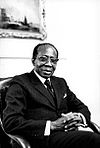塞雷尔人
西非民族
塞雷尔人(法语:Sérères;英语:Serer people),西非民族,依人口计算是塞内加尔的第三大民族,占塞内加尔人口的15%[4]。在冈比亚北部和毛里塔尼亚南部也有分布[5]。
| 塞雷尔人 | |
|---|---|
  | |
| 总人口 | |
| 180万以上[1] | |
| 分布地区 | |
| 184万 | |
| 53,567[2] | |
| 3,500 | |
| 语言 | |
| 塞雷尔语、昌因语、沃洛夫语 法语(塞内加尔、毛里塔尼亚) 英语(冈比亚) | |
| 宗教信仰 | |
| 伊斯兰教、基督教、塞雷尔宗教[3] | |
| 相关族群 | |
| 沃洛夫人、乔拉人、图库洛尔人、莱布人 | |
塞雷尔人的祖先来自塞内加尔和毛里塔尼亚边界的塞内加尔河河谷地区,在11世纪至12世纪南迁,15世纪至16世纪因战乱和宗教压力再度南迁[6][7][8]。传统上从事定居农业,精于农耕和移牧式畜牧[7][9]。
塞雷尔人在历史上长期实行母系制度,抗拒伊斯兰教传播,在19世纪起先后和西非的伊斯兰教圣战者和法国殖民者对抗[10][11][12]。然而到20世纪,绝大部分塞雷尔人都皈依伊斯兰教,以苏菲派为主[13][10]。和塞内加尔的其他民族相似,塞雷尔人的社会也存在着基于氏族内婚和奴隶制度的阶级分野[14][15][16]。
名人
编辑- 利奥波德·塞达尔·桑戈尔,塞内加尔首任总统
- 阿卜杜·迪乌夫,塞内加尔第二任总统,法语圈国际组织第二任秘书长
- 马默·比莱姆·迪乌夫,塞内加尔足球运动员
参考文献
编辑- ^ Agence Nationale de Statistique et de la Démographie. Estimated figures for 2007 in Senegal alone
- ^ National Population Commission Secretariat. 2013 Population and Housing Census: Spatial Distribution (PDF). Gambia Bureau of Statistics. The Republic of The Gambia. 2005-04-30 [2017-12-29]. (原始内容存档 (PDF)于2018-01-03).
- ^ Claire L. Adida; David D. Laitin; Marie-Anne Valfort. Why Muslim Integration Fails in Christian-Heritage Societies. Harvard University Press. 2016: 33–34 [2021-02-08]. ISBN 978-0-674-50492-9. (原始内容存档于2021-04-27).
- ^ Senegal (页面存档备份,存于互联网档案馆), CIA Factsheet
- ^ [1] (页面存档备份,存于互联网档案馆) Ethnologue.com
- ^ Galvan, Dennis Charles, The State Must Be Our Master of Fire: How Peasants Craft Culturally Sustainable Development in Senegal Berkeley, University of California Press, 2004 p. 51
- ^ 7.0 7.1 Elizabeth Berg; Ruth Wan; Ruth Lau. Senegal. Marshall Cavendish. 2009: 63 [2021-02-08]. ISBN 978-0-7614-4481-7. (原始内容存档于2021-03-03).
- ^ Leonardo A. Villalón. Islamic Society and State Power in Senegal: Disciples and Citizens in Fatick. Cambridge University Press. 2006: 54–55 [2021-02-08]. ISBN 978-0-521-03232-2. (原始内容存档于2021-03-03)., Quote: "Serer oral tradition recounts the group's origins in the Senegal River valley, where it was part of, or closely related to, the same group as the ancestors of today's Tukulor."
- ^ Natural Resources Research, UNESCO, Natural resources research, Volume 16, Unesco (1979), p. 265
- ^ 10.0 10.1 James Stuart Olson. The Peoples of Africa: An Ethnohistorical Dictionary. Greenwood. 1996: 516 [2021-02-08]. ISBN 978-0-313-27918-8. (原始内容存档于2020-08-04).
- ^ Pierret, Paul, "Dictionnaire d'archéologie égyptienne", Imprimerie nationale 1875, p. 198-199 [in] Diop, Cheikh Anta, "Precolonial Black Africa", (trans: Harold Salemson), Chicago Review Press, 1988, p. 65
- ^ See Godfrey Mwakikagile in Martin A. Klein. Islam and Imperialism in Senegal Sine-Saloum, 1847–1914, Edinburgh at the University Press (1968)
- ^ Leonardo A. Villalón. Islamic Society and State Power in Senegal: Disciples and Citizens in Fatick. Cambridge University Press. 2006: 71–74 [2021-02-08]. ISBN 978-0-521-03232-2. (原始内容存档于2020-10-25).
- ^ Danielle Resnick. Urban Poverty and Party Populism in African Democracies. Cambridge University Press. 2013: 165. ISBN 978-1-107-65723-6., Quote:"One reason for the low salience of ethnic identity is because, like some other West African societies, many ethnic groups in Senegal are structured by caste. For example, the Wolof, Serer, and Pulaar-speaking Toucouleur are all caste societies."
- ^ Martin A. Klein. Islam and Imperialism in Senegal: Sine-Saloum, 1847–1914. Stanford University Press. 1968: 7–11. ISBN 978-0-8047-0621-6.
- ^ Tal Tamari. The Development of Caste Systems in West Africa. The Journal of African History (Cambridge University Press). 1991, 32 (2): 221–250. JSTOR 182616. doi:10.1017/s0021853700025718., Quote: "[Castes] are found among the Soninke, the various Manding-speaking populations, the Wolof, Tukulor, Senufo, Minianka, Dogon, Songhay, and most Fulani, Moorish and Tuareg populations, (...) They are also found among (...) and Serer groups."
外部链接
编辑- Moving from Teaching African Customary Laws to Teaching African Indigenous Law (页面存档备份,存于互联网档案馆). By Dr Fatou. K. Camara
- Ethnolyrical. Tassou: The Ancient Spoken Word of African Women (页面存档备份,存于互联网档案馆)
- The Seereer Resource Centre (页面存档备份,存于互联网档案馆)
- Seereer Radio (页面存档备份,存于互联网档案馆)
- Seereer Resource Centre and Seereer Radio Podcast (页面存档备份,存于互联网档案馆)
- Seereer Heritage Press (页面存档备份,存于互联网档案馆)